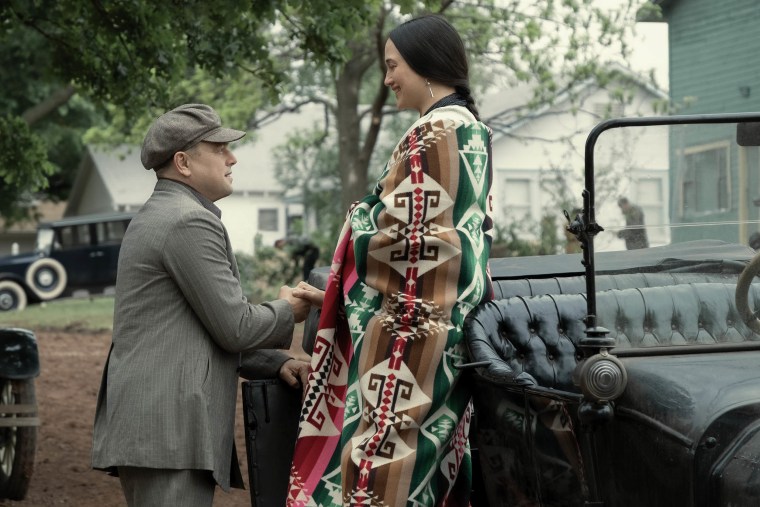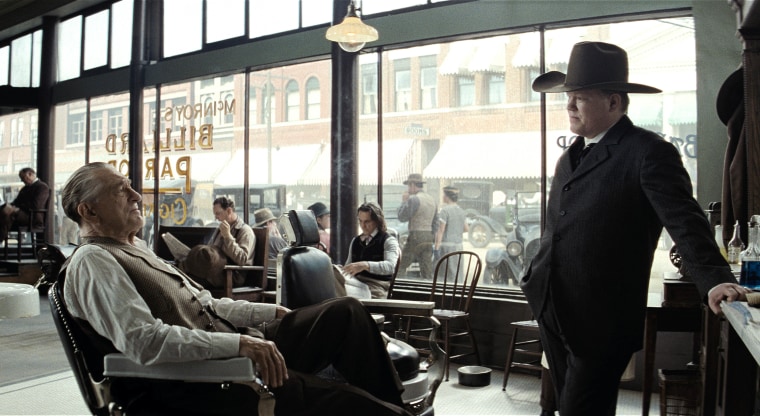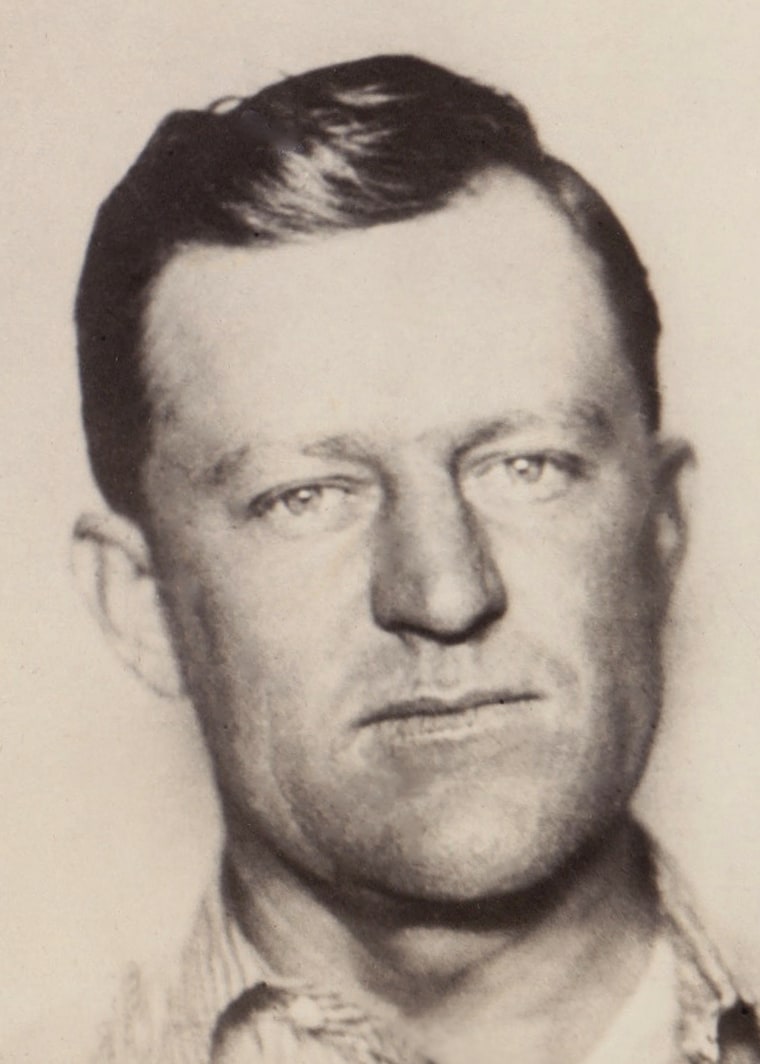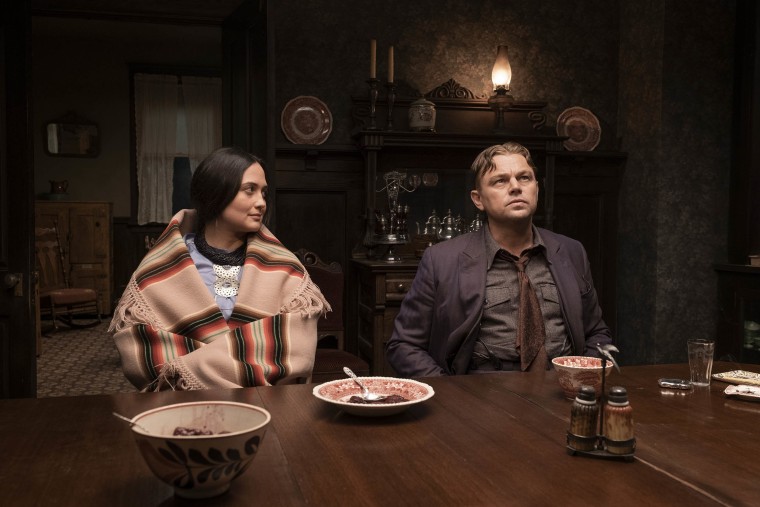Journalist David Grann took a trip out to the Osage Nation in Oklahoma in 2012 after hearing about what happened in the early 1900s. Following the discovery of oil on their land, dozens of Osage were either murdered or died under mysterious circumstances.
Inside the Osage Nation Museum in Pawhuska, Oklahoma, Grann saw a sweeping panoramic photo of members of the Osage Nation along with white settlers taken in 1924. He then noticed a panel of the photograph had been cut out, and he asked the museum's director why it had been removed.
"She said it contained a figure so frightening she had decided to remove it," Grann tells TODAY.com. "And I'll never forget this — she then pointed to the missing panel and she said, 'The devil was standing right there.'"
The director, Kathryn Red Corn, went to the basement of the museum and pulled the missing panel out for Grann, which depicted a photo of William Hale, a white settler who was later convicted of murder.

"I was so haunted by that moment and by that photograph, because the Osage have removed it not to forget what had happened, but because they can't forget," he said. "And yet there were so many people, including myself, who had never been taught this history."
Grann then started writing a book, which would later become "Killers of the Flower Moon," about the so-called Reign of Terror, the period that encompasses dozens of murders of Osage and how the investigation into their deaths helped found the modern-day Federal Bureau of Investigation.
Grann's book has been adapted into a film of the same name, directed by Martin Scorsese and starring Robert De Niro as Hale, Leonardo DiCaprio as his nephew Ernest Burkhart and Lily Gladstone as his wife Mollie Burkhart, an Osage woman.

The film follows Ernest as he moves to Oklahoma to work for his uncle. He's one of many white settlers who flocked to the area after oil was discovered underneath the Osage reservation. Ernest later meets Mollie, a wealthy member of the Osage Nation, while he's working as her chauffeur.
Hale, a beloved member of the community with contacts throughout every aspect of the town including law enforcement, proposes a plan to Ernest — if he married Mollie, he would inherit her headrights when she dies, and therefore her oil money.

And so begins a tragic trail of murder and death, as Hale executes the plan to gain oil headrights through the systematic killing of Mollie's family members and other members of the tribe, though he never killed any of them himself.
Hale and Ernest would enlist their contacts throughout the town to do the dirty work, and over the course of several years, Mollie's mother and sisters died in horrific ways — including a bombing, an execution-style killing and poisoning.
Tom White, a Texan investigator with the then-Bureau of Investigation, was directed by the bureau’s head, J. Edgar Hoover, to report to the Osage Nation to investigate the deaths. He assembled a group of undercover agents and garnered enough evidence to arrest Hale, Ernest and several of their accomplices.

As depicted in the film, even Mollie, a diabetic, was being poisoned by local doctors through her insulin shots — and her husband Ernest administered the tainted vials to his own wife in their home.
Once she was taken out of their care, she regained her health and watched her husband and his uncle's trials, according to Grann's book.
Hale was later convicted of first-degree murder in the death of Henry Roan, Mollie's cousin, while Ernest pleaded guilty to ordering the bombing that killed Mollie's sister Rita and her husband Bill Smith, according to Grann’s book.

Both Hale and Burkhart were sentenced to life in prison, though Burkhart was paroled in 1937 and Hale was released in 1947 after serving 20 years in prison, according to Grann's book.
Hale died in 1962 in an Arizona nursing home, and Ernest lived out his days back in Osage County, Oklahoma after he was pardoned. Ernest died in 1986, in a "mice-infested trailer just outside of Osage County," Grann wrote.
Margie Burkhart, Ernest and Mollie's granddaughter, said in an interview with Grann that after Ernest's death, his ashes were given to her father and Ernest's son, Cowboy Burkhart, with the instructions to spread them around the Osage Hills.
"Those ashes were in the house for days, just sitting there," she told Grann. "Finally, one night my dad got real mad and took the box and just chucked it over a bridge."
The true number of victims of the Reign of Terror is unknown, and Hale was not the single conspirator — according to his book, Grann discovered what he called a "culture of killing," dozens of deaths occurred from at least 1918 to at least 1931 — far further from the range of 1921 to 1926 cited by most historical accounts.
As Louis F. Burns, an Osage historian, said in the documentary "Osage Tribal Murders:" "I don't know of a single Osage family which didn't lose at least one family member because of the head rights."

